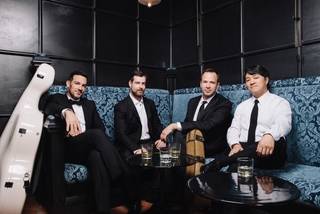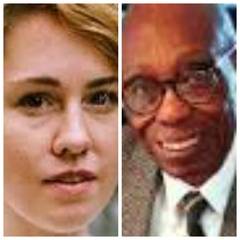|
Back
Verklärte... Stunde? New York
Church of the Intercession
05/04/2024 -
George Walker: Lyric for Strings
Samuel Barber:Adagio for Strings, opus 11
Kevin Puts: Home (Part 1)
Caroline Shaw: Microfictions (Volume 1)
Miró Quartet: Daniel Ching, William Fedkenheuer (Violins), John Largess (Viola), Joshua Gindele (Cello) 
Miró Quartet (© Michael Thad Carter)
“When I was a kid, I think music was a big retreat for me. It was just colors and sounds and it was such a magical place”, she says. “I’m not religious and I don’t believe in magic or mystical things, but what if music is this thing that you cannot see or touch or taste, but it does something, it moves you? That feels like magic to me in some way, and I want to let myself just continue to always think about that. There’s something very childlike about thinking of music like that, I think.”
Caroline Shaw
Forgive the defiling of Schoenberg’s title, but Transfigured Hour was the only way to describe the Miró Quartet performing in the Mausoleum by the cemetery in the Church of the Intercession. Was this emotional transformation due to the ancient Gothic buttresses and Norman‑style stones? The candles illuminating both the stage and the entrance? Or perhaps the two glasses of wine in anticipation of the hour‑long concert?
Those helped, probably. But the transfiguration was, of course, entirely due to the Miró Quartet, to its four rare transforming American works, and to sounds which could have been called “soul”.
(In the original Greek sense of “life, spirit, consciousness”.)
The works here were unrelated to Classical, Romantic or 20th Century atonality. Both George Walker’s Lyric for Strings and its progenitor, Barber’s Adagio for Strings (both in their original string quartet version) were shadowy, moody, for a few seconds triumphant.
Kevin Puts’ Home was restless, mysterious. One could only wish for the complete quartet, written for the Miró. As for Caroline Shaw..., well, the moods were playful or mysterious, or–with spoken lyrics–actually funny. As variegated as Ms. Shaw herself.
And offhand, I can’t think of another quartet (not even Kronos) which could preserve these feelings, making these sixty minutes into a timeless infinity.

C. Shaw/G. Walker (© Kait Moreno)
The latter (mea culpa) was a verbal affectation. But from the first notes of George Walker’s oft‑played work, one was struck by an individuality not heard in the usual orchestral version. Orchestras give the texture of the work. The Miró changed that to–forgive me–the inspired original lines of Joan Miró himself.
Barber’s Adagio is usually played by orchestra (though presumably arranged for marching‑band or barber-shop-quartet or ukulele-and-accordion). The Opus 11 String Quartet was the original, and Miró was able to give each player time to make it work. In fact, that Grand Climax was not what audiences were waiting for. Those rich notes by Daniel Ching were now part of Barber’s original structure.
Kevin Puts is probably the most prodigious composer since Georg Telemann, and the first section of his quartet Home was a tribute to his craft. He started with a simple violin solo over a drone. Then the work floated away, changing harmonies, the drone now changing to an incessant beat, mainly on cello, and into an undefinable but always accessible language.
Finally came Caroline Shaw’s Microfictions. Texts read by the performers before each “micro‑section” were aphoristic, poetic, cusping on musical imagery. (Example: The complete taxonomy of verse forms is buried in a cardboard box beneath a chord that fell from grace). The music, like everything by this composer, combined lyricism, at times a dazzling dissonance, and finally a movement which was like an illusion. Tonelessnes, triads, chords and solos leading to whispers.
For an encore, the Miró Quartet started with some cryptic fiddling, leading to the second most beautiful song in the American repertoire, Over the Rainbow.
Not that they needed such beauty. Their whole recital created, in this sepulchral space, mood‑filled metamorphoses.
Harry Rolnick
|